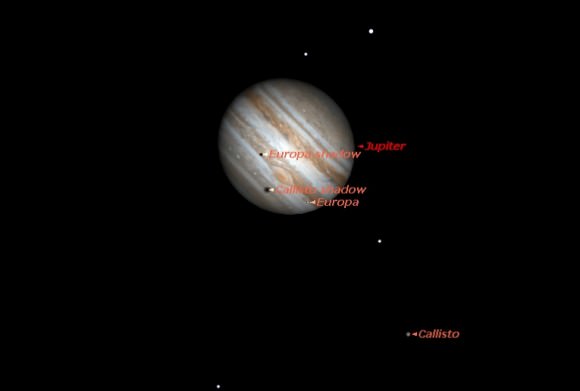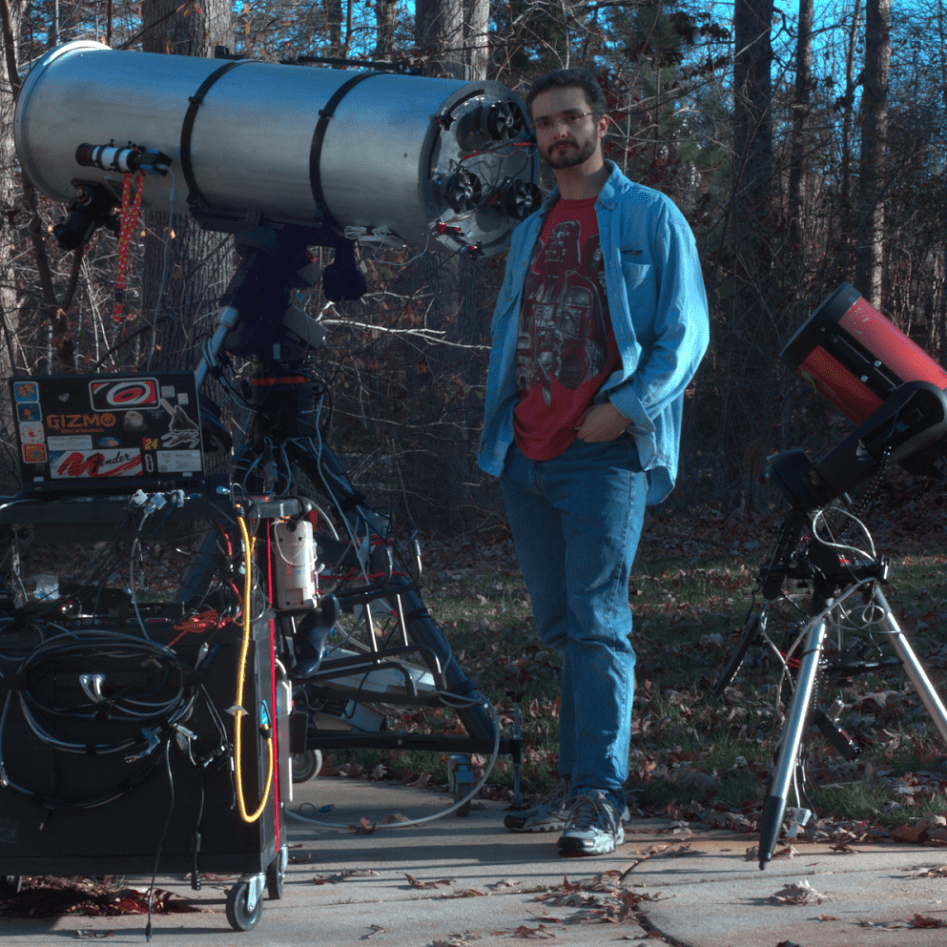It’s always a thrill to watch the action at Jupiter, as its moons pass in front of and behind the gas giant planet. We wrote recently about this month’s opposition of Jove on January 5th, marking the start of the Jupiter evening viewing season for 2014.
Astrophotographer Michael A. Philips also recently undertook a challenging series of sequences of Jupiter and its moons Io and Ganymede, with stunning results. You can see the motion of Jupiter’s rotation, the Great Red Spot and even a bit of cloud swirl as Io disappears behind Jupiter and Ganymede begins to transit in front and cast a shadow back onto the Jovian cloud tops.
Concerning the capture, Michael wrote on his blog:
“This night was a lucky night. I had not looked at the weather forecast enough to know if it would be good or not. Cold temps aside, I decided earlier in the day to set up and go out with the 14” f/4.5 scope named Akule. As an added bonus, Mitchell Duke tipped me off to a transit of the Jovian moon, Ganymede.”
Note that Jupiter and its moons are currently casting their shadows nearly straight back from our perspective. Expect that to change, however, in the coming months,as Jupiter heads towards eastern dusk quadrature on April 1st and we see the action from a sideways angle. Watch the video in full screen mode and you’ll note that Mike captured some detail on the surface of Ganymede as well! Generally, at the eyepiece, the moons of Jupiter disappear entirely due to low contrast against the bulk of the planet, with only the black dot of the shadow seen… this video capture gives the ingress of Ganymede at the start of the transit a great 3-D appearance.
Webcam imaging of planets has really taken off in the past decade, with backyard astronomers now routinely capturing images that far surpass professional and textbook images from just a decade prior. Great images can be taken using nothing more than a telescope, a laptop, free image stacking software such as Registax, and a webcam converted to fit into an eyepiece holder… you may find that you’ve got the gear sitting around to image Jupiter, tonight.
Mr. Phillips rig, however, is a little more advanced. He notes in the description of the video that he’s using a Flea3 camera from PointGrey Research with a 5x Barlow lens yielding a 9200mm focal length. He’s also shooting at 120 frames per second, and taking successive red, green and blue images for 30 seconds. Finally, a derotation of Jupiter – yes, it really rotates that quickly, even in a short sequence – is accomplished using a sophisticated program named WINJupos.
Video stacking gives processors the ability to “freeze” and nab the best moments of seeing from thousands of frames. Some imagers hand select frames one by one, though many programs, such as Registax, use algorithms to nab the best frames from a preselected percentage of the total shot.
Local seeing conditions also play a key role in image capturing.
“I moved far away from the house as possible, and I think that helped some,” Michael noted. “I also started cooling the spit out of the mirror, aggressively. Even when cooled for a few hours in the winter, the heat in the Pyrex mirror comes back. I think there’s a small heat engine inside the beast!”
For best results, imagers tend to go after planets when they’re at their highest in the sky, and viewed through the least amount of turbulent atmosphere. This is when a planet is transiting the local north to south meridian, and when it’s at opposition, which Jupiter is this month. At opposition, a planet transits at local midnight. The same goes for the best opportunities for visual observing as well.
Shadow transits of Jupiter’s moons are also just plain fun to watch. In an often unchanging universe, they offer a chance to see something unfolding in real time. Jupiter has the fastest rotation of any planet at 9.9 hours, and the large Galilean moons of Io, Europa, Ganymede and Callisto are tidally locked in their rotation, keeping one hemisphere permanently turned towards Jupiter like the Moon does orbiting the Earth. The inner three moons also keep a 1:2:4 orbital resonance, assuring you’ll never see more than three of the four Galilean moons transiting from your line of sight at once. You can see two of the inner three moons, plus Callisto in transit, but never all four at the same time! A triple transit last occurred on October 12th, 2013, and will next occur for observers in eastern Europe and Africa this year on June 3rd.
We’re also currently in the midst of a series of shadow transits for the outermost Galilean moon Callisto, which end in July 2016. Can you identify the different moons by the size and hue of shadows they cast? Sky & Telescope publishes a great table for the ingress and egress of Jupiter’s moons. You can also check them out using the freeware program Stellarium.

Can’t wait that long? A double shadow transit involving Europa and Callisto occurs in just a few weeks for western North America from 10:20 UT-12:44UT on the morning of February 6th, a chance for another stunning animation sequence…
Congrats to Michael Phillips on a great capture!

